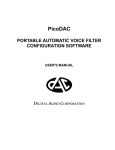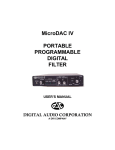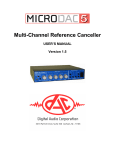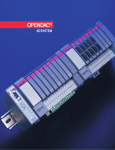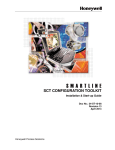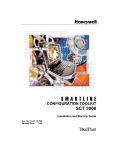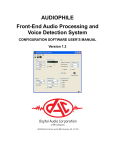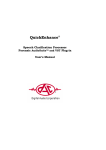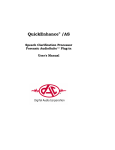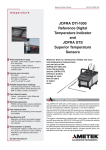Download Digital Audio Corporation MicroDAC IV User`s manual
Transcript
MicroDAC IV PORTABLE PROGRAMMABLE DIGITAL FILTER CONFIGURATION SOFTWARE USER’S MANUAL DIGITAL AUDIO CORPORATION A DRI COMPANY MicroDAC IV PORTABLE PROGRAMMABLE DIGITAL FILTER CONFIGURATION SOFTWARE User’s Manual March 31, 2003 Document Number: 990398 Version 1.0 DIGITAL AUDIO CORPORATION A DRI COMPANY 5121 Holly Ridge Drive Raleigh, NC 27612 Phone: 919 782 6767 Fax: 919 782 6766 [email protected] www.dacaudio.com Copyright © 1999 by Digital Audio Corporation. All rights reserved. TABLE OF CONTENTS 1. OVERVIEW ..................................................................................................................................................... 2 1.1 Introduction ............................................................................................................................................... 2 2. INSTALLATION............................................................................................................................................... 4 2.1 Software Requirements ................................................................................................................................ 4 2.2 Installing the Software .................................................................................................................................. 4 3. MICRODAC IV CONFIGURATION CONTROL PANEL ........................................................................................ 5 3.1 MicroDAC IV Control Panel ..................................................................................................................... 5 3.2 Customizing Filter Sets ............................................................................................................................ 5 3.3 Input Limiter .............................................................................................................................................. 6 3.4 Input or Output Highpass Filter ..................................................................................................................... 7 3.5 Output Lowpass Filter .............................................................................................................................. 7 3.6 Output Automatic Gain Control ..................................................................................................................... 7 3.7 Panel Locking Controls ............................................................................................................................ 7 3.7.1 Utilities Menu Option........................................................................................................... 8 3.7.2 Panel Lock Settings Window............................................................................................... 8 3.8 Program MicroDAC IV Button.................................................................................................................. 9 4. PROGRAMMING THE MICRODAC IV ........................................................................................................11 4.1 Selecting the correct COM Port....................................................................................................................11 4.2 Transferring the Filter Configurations ...........................................................................................................11 5. STORING FILTER CONFIGURATIONS .............................................................................................................13 5.1 Save File Dialog Box ...............................................................................................................................13 6. RECALLING FILTER CONFIGURATIONS .........................................................................................................15 6.1 Open File Dialog Box ..............................................................................................................................15 7. FILTER CONTROL WINDOWS ....................................................................................................................17 7.1 One channel adaptive filter .....................................................................................................................17 7.2 Lowpass filter ...........................................................................................................................................18 7.3 Highpass filter ..........................................................................................................................................19 7.4 Bandpass filter .........................................................................................................................................20 7.5 Bandstop Filter.........................................................................................................................................22 7.6 Comb Filter ..............................................................................................................................................23 7.7 Notch Filter...............................................................................................................................................24 7.8 Slot Filter ..................................................................................................................................................25 7.9 20-Band Graphic Equalizer.....................................................................................................................27 7.10 Spectral Graphic Equalizer ...................................................................................................................27 7.11 Imported Coeffecient File......................................................................................................................31 7.11.1 Coefficient File Format ...................................................................................................... 31 7.12 Pass Thru Filter .....................................................................................................................................33 7.13 Two Channel Adaptive Filter ......................................................................................................................33 i 8. ADJUSTING MAXIMUM TAPS FOR EACH STAGE............................................................................................35 ii LIST OF FIGURES Figure 3-1 MicroDAC IV Control Panel .................................................................................................................... 5 Figure 3-2 Input Limiter Controls............................................................................................................................. 6 Figure 3-3 Highpass Filter....................................................................................................................................... 7 Figure 3-4 Lowpass Filter........................................................................................................................................ 7 Figure 3-5 Automatic Gain Control .......................................................................................................................... 7 Figure 3-6 Utilities Menu ......................................................................................................................................... 8 Figure 3-7 Panel Lock Settings Windows................................................................................................................. 9 Figure 4-1: A Typical Computer’s Serial Ports.........................................................................................................11 Figure 4-2: MicroDAC IV Transfer Window .............................................................................................................11 Figure 4-3: MicroDAC IV Transfer Window .............................................................................................................12 Figure 5-1: Save As Setup File Window..................................................................................................................13 Figure 6-1: Open Setup File Window......................................................................................................................15 Figure 7-1 1CH Adaptive Filter Control Window......................................................................................................17 Figure 7-2: Lowpass Filter Control Window.............................................................................................................18 Figure 7-3: Lowpass Filter Graphical Description ....................................................................................................19 Figure 7-4: Highpass Filter Control Window............................................................................................................19 Figure 7-5: Highpass Filter Graphical Description ...................................................................................................20 Figure 7-6: Bandpass Filter Control Window...........................................................................................................21 Figure 7-7: Bandpass Filter Graphical Description ..................................................................................................21 Figure 7-8: Bandstop Filter Control Window............................................................................................................22 Figure 7-9: Bandstop Filter Graphical Description ...................................................................................................23 Figure 7-10: Comb Filter Control Window ...............................................................................................................23 Figure 7-11: Comb Filter Graphical Description.......................................................................................................24 Figure 7-12: Notch Filter Control Window ...............................................................................................................25 Figure 7-13: Notch Filter Graphical Description.......................................................................................................25 Figure 7-14: Slot Filter Control Window ..................................................................................................................26 Figure 7-15: Slot Filter Graphical Description..........................................................................................................26 Figure 7-16: 20-Band Graphic Equalizer Control Window........................................................................................27 Figure 7-17: Spectral Graphic Equalizer Window ....................................................................................................28 Figure 7-18: New Spectral Graphic Equalizer Display .............................................................................................28 Figure 7-19: Spectral Graphic Draw in Progress .....................................................................................................29 Figure 7-20: Completed Spectral Graphic Draw......................................................................................................29 Figure 7-21: Spectral Graphic Edit Window ............................................................................................................29 Figure 7-22: Spectral Graphic Define Edit Region...................................................................................................30 Figure 7-23: Spectral Edit In Progress....................................................................................................................30 Figure 7-24: Completed Spectral Graphic Edit........................................................................................................30 Figure 7-25: Normalized Spectral Graphic Equalizer ...............................................................................................31 Figure 7-26: Open Imported Coefficient File Dialog Box..........................................................................................31 Figure 7-27: Pass Thru Filter Selection...................................................................................................................33 Figure 7-28 Two Channel Adaptive Filter Control Window.......................................................................................34 Figure 8-1 Adjust Maximum Taps Button................................................................................................................35 Figure 8-2 Adjust Maximum Taps Control Screen ...................................................................................................35 iii 1 1. OVERVIEW 1.1 Introduction The MicroDAC IV Configuration Software allows for complete setup and control of the three preset adaptive filters and four configurable filters, each consisting of up to two stages. The software provides an easy to use, intuitive interface for configuring the filter settings and transferring them to the MicroDAC IV. The Configuration Software provides: • • • • • • • • • Choice of two stages within each filter for a total of 3600 taps Graphical representation of the actual audio path through the digital filters Configurable filter tap distribution between adaptive filter stages 13 different filter types to choose from Selectable Input Limiter, Lowpass Filter, Highpass Filter, and Output Automatic Gain Control (AGC) for each filter setup Storable configuration settings for later recall and use Automatic COM Port detection when transferring filter to the MicroDAC IV Front panel locking utility to protect accidental front panel switch changes Online help for quick and easy access Each filter can be configured in a Mono Single (one stage), Mono Series (two stages in series), or StereoLinked (two stages in parallel) mode. The stages within each filter can be independently selected from one of the following filter types: • • • • • • • • • • • • One Channel Adaptive Filter Two Channel Adaptive Filter (first stage in Mono modes only) Lowpass Filter Highpass Filter Bandpass Filter Bandstop Filter Comb Filter Notch Filter Slot Filter 20 Band Graphic Equalizer Spectral Graphic Equalizer Pass Thru Filter (digital bypass) Floating-point format coefficient text files can be imported as well. A description of each filter type, its application and a definition of the control parameters can be found in the following sections. 2 3 2. INSTALLATION 2.1 Software Requirements This Windows software-based product consists of an installation CD, User’s manual, and communications cable. Supported operating systems include Windows 95/98/ME/2000/NT/XP. The PC should have the following minimum capabilities: Ø Ø Ø Ø Ø 200MHz Pentium III processor 32MB RAM 10 MB of free hard disk space storage CD-ROM drive for installing the software 800x600 resolution SVGA monitor 2.2 Installing the Software To install the MicroDAC IV software, simply insert the MicroDAC IV Installation CD into your CD-ROM drive1. Often times after the installation is complete you will be instructed to reboot your system. Once the system has rebooted you can run the MicroDAC IV software by clicking on the Start button, then the MicroDAC IV menu, then the MicroDAC IV icon. 1 If the installation software does not automatically run after several seconds, you will need to manually start the installation as follows: With the MicroDAC IV Installation CD in your CD-ROM drive click on the Start menu and then the Run option. In the window that appears, type: X:\setup.exe And click OK or press the Enter key. “X” would be the drive letter of your CD-ROM. The installation program will then start; follow the directions given in the installation program. 4 3. MICRODAC IV CONFIGURATION CONTROL PANEL 3.1 MicroDAC IV Control Panel Figure 3-1 MicroDAC IV Control Panel At the top of the MicroDAC IV Control Panel is a Menu Bar. From the File menu, you can choose to create a New2 filter configuration, Open a filter configuration file, Save a file As a different or similar file name, Program the MicroDAC IV, adjust the Panel Lock Settings to be programmed, use the Utilities to directly control the panel lock settings, select a COM Port, or Exit the software. From the Help menu item you can view the Contents of the software help file, Search for Help On a topic in this help file, or read information About the MicroDAC IV software. Below the Menu Bar is the Toolbar. Each small icon allows a quick shortcut to some of the Menu Bar items. Each icon represents the menu function of New, Open, and Save As, respectively. Beside the tool icons is the Program MicroDAC IV button, and on the rightmost portion of the toolbar is the Panel Lock Setting indicator. 3.2 Customizing Filter Sets The MicroDAC IV Control Panel shows a graphical representation of the audio path through the different processes in the MicroDAC IV. As each different filter type is selected, and features such as the Limiter, Highpass Filter, Lowpass Filter, and Output AGC are selected or removed, the Control Panel will update its block diagram display. The MicroDAC IV Control Panel allows each of the seven filter setups to be configured. Each setup can be selected by clicking on the "tabs" that correspond to the labels on the front panel MODE switch of the MicroDAC IV. There are up to two Stages for each filter. The Stage Mode radio buttons control how the stages are configured. The options are described as follows: 2 The New menu option allows you to reset the first three filter modes to their factory defaults. Modes A, B, C, and D will be configured as Mono Series, Stage 1 filter set to Pass Thru, and no AGC. This is a quick and easy way to configure an entirely new filter configuration. 5 • Mono Single configures the MicroDAC IV to apply a single large stage (Stage 1) of filtering to the Left Input only. When using the 2CH Adaptive filter, the Right Input is used as the cancellation reference. The output of Stage 1 is routed to both the Left and Right Outputs. • Mono Series configures the MicroDAC IV to split its filtering resources among two smaller stages (Stage 1 and 2), applying them in series to the Left Input. When using the 2CH Adaptive filter, the Right Input is used as the cancellation reference (the 2CH Adaptive filter is only available on Stage 1.) The output of Stage 1 is routed to the input of Stage 2, and the output of Stage 2 is routed to both the Left and Right Outputs. • Stereo Linked configures the MicroDAC IV to apply the two stages (Stage 1 and 2) to a stereo signal. The Left Input is routed through Stage 1 and the Right Input is routed through Stage 2. The outputs of Stage 1 and 2 are routed to the Left and Right Outputs, respectively. The 2CH Adaptive filter is not available with the Stereo Linked option. The Stage 2 filter is identical to Stage 1; any changes made to the settings of Stage 1 will also be applied to Stage 2. The stages can implement any of the following filter types: • • • • • • • • • • • • • One Channel Adaptive Filter Lowpass Filter Highpass Filter Bandpass Filter Bandstop Filter Comb Filter Notch Filter Slot Filter 20 Band Graphic Equalizer Spectral Graphic Equalizer Imported Coefficient File Two Channel Adaptive Filter3 Pass Thru Filter Once the filter type is selected, click on the Control button to bring up the control window for that filter. This window allows you to customize the parameters for desired filter performance. After selecting the values for each parameter, click on the OK button. Refer to Appendix A for more information on the filter types and full explanations of their parameters. 3.3 Input Limiter The Input Limiter controls are shown in Figure 3-2. The Input Limiter helps prevent the input signals from distorting on overload and is “linked” so that an overload on either input channel will cause the levels to be reduced equally on both input channels. Selecting the “Limiter In” radio button will enable the Input Limiter for the filter setup, while “Limiter Out” will disable this feature. Figure 3-2 Input Limiter Controls 3 Not available in Stage 2 6 3.4 Input or Output Highpass Filter The Highpass Filter controls are shown in Figure 3-3. The 200 Hz Highpass Filter is used to remove any low frequency noises that may need to be removed before processing (“Input HPF”) or after processing (“Output HPF”). Selecting “No HPF” will disable this feature. This filter is separate from the Highpass Filter described in Appendix A, and has no adjustable parameters. Figure 3-3 Highpass Filter 3.5 Output Lowpass Filter The output Lowpass Filter controls are shown in Figure 3-4. This adjustable filter is used to remove high frequency hiss. The selectable cutoff frequencies are: • • • • • • 2500 Hz 3200 Hz 3500 Hz 3900 Hz 4500 Hz 5000 Hz This filter is applied after Stage 1 and 2, and is separate from the Lowpass Filter described in Appendix A. Figure 3-4 Lowpass Filter 3.6 Output Automatic Gain Control The output AGC (Automatic Gain Control) radio buttons are shown below. Each filter setup can have the AGC turned off via the “No AGC” option, or have “10dB”, “20dB”, or “30dB” of AGC applied to the output signal. When the AGC is active, it will boost a low level output signal by up to the maximum amount specified. Figure 3-5 Automatic Gain Control 3.7 Panel Locking Controls 7 The MicroDAC IV Configuration Software allows the front panel controls to be locked to prevent accidental tampering by nontechnical operators. This feature is useful when the MicroDAC IV is deployed in a tactical setting. There are three locking options, described as follows: 3.7.1 • No Lock: This option unlocks all the front panel controls, allowing the user to adjust the input levels and select any filtering mode via the MODE switch. • Mode Lock: This option forces the unit to operate only with the settings for a specified MODE, regardless of the actual switch positon. The Input Level controls, however, are still adjustable. • Lock All: This option locks both the MODE switch and the Input Level controls; thus, all front panel controls are completely disabled, and changing them will have no effect. Utilities Menu Option There are two methods of adjusting the panel lock settings. One way is using the Panel Lock Settings Window (See Section 3.7.2). The other way is via the Utilities option in the File menu (Figure 3-6). Figure 3-6 Utilities Menu The three options within the Utilities menu allow the MicroDAC IV panel controls to be locked or unlocked without having to reprogram the entire unit. When selecting one of the “Lock” options, the unit is locked to the current front panel settings. For example, to lock the MODE switch to “B”, first turn the MODE switch to “B”, then within the Utilities menu choose Lock Mode Switch. This will work even if the front panel is currently locked. 3.7.2 Panel Lock Settings Window The second method is to use the Panel Lock Settings control window shown in Figure 3-7. This window can be accessed either by clicking on the Panel Lock Settings label in the top right corner of the MicroDAC IV Control Panel, or via the Panel Lock Settings option in the File menu. 8 Figure 3-7 Panel Lock Settings Windows The lock setting to be programmed into the MicroDAC along with the filter settings can be selected by clicking on appropriate radio button in the “Panel Locked Mode” area of the window. When the Mode Switch Lock option is selected, the “Mode Switch Setting” area of the window will be enabled, allowing the desired MODE switch setting to be specified. When the Mode Switch and Level Controls Locked option is selected the, “Level Controls” area of the window will be enabled. There, the desired Input Level to be programmed into the MicroDAC IV can be specified. The Retrieve Level Settings button will retrieve the current Input Level settings from the MicroDAC IV. This feature is useful for empirically determining the desired level settings using the actual front panel controls. Should you attempt to retrieve the Input Levels from a MicroDAC IV that has the panel lock set to “Lock All”, you will receive a message informing you to first unlock the front panel via the Utilities menu option. 3.8 Program MicroDAC IV Button See Section 4. 9 10 4. PROGRAMMING THE MICRODAC IV 4.1 Selecting the correct COM Port The COM Port menu option within the File menu allows you to select the COM Port on which the software will first attempt to communicate with MicroDAC IV when programming it. If you are unsure which COM Port your MicroDAC IV is connected to, then leave it set at the default option of COM 1, and the software will automatically search all COM Ports until the MicroDAC IV is found. An example of a computer’s COM Port connections is shown in Figure 4-1. Figure 4-1: A Typical Computer’s Serial Ports 4.2 Transferring the Filter Configurations The Program MicroDAC IV button on the toolbar starts the process of searching for a MicroDAC IV and transferring the filter settings to the MicroDAC IV via the serial port. This function can also be selected through the File option in the Menu Bar. After the Program MicroDAC IV button is pressed, you will see a window appear that asks you if you are prepared to program all seven filters. This is to remind you that you only need to program the MicroDAC IV one time once you have all the filters set up the way you want them. Figure 4-2: MicroDAC IV Transfer Window Several messages will appear in the transfer window ito inform you when the software is using the Auto COM Port detection feature to find the MicroDAC IV, calculating the coefficients, and finally programming the MicroDAC IV. The COM port that is being used to transfer the settings will appear in the lower right corner of the Transferring Filters window. As the filters are transferred, the progress bar will display how much of the total transfer has been completed. Once the transfer is complete, the window will disappear and the Main Control Window will become active again. 11 Figure 4-3: MicroDAC IV Transfer Window Programming of the MicroDAC IV can be stopped at any time by pressing the Cancel button. A message window may then appear to inform you that the download has been aborted and that the filters stored in MicroDAC IV are no longer valid. Because the download was stopped before it was completed, the filter settings stored in the MicroDAC IV may no longer be usable. It is advised that a valid configuration be transferred to the MicroDAC IV by repeating the Program MicroDAC IV procedure mentioned above. 12 5. STORING FILTER CONFIGURATIONS 5.1 Save File Dialog Box Application: To save time configuring the MicroDAC IV control settings, complete setups may easily be stored to disk setup files for future recall. Store a setup to a disk file as follows: 1. Click on File on the MicroDAC IV menu bar. When the pulldown menu appears, click on Save As (or click on the "floppy disk" icon on the toolbar). This will cause the following window to appear: Figure 5-1: Save As Setup File Window 2. If you desire to place the setup file into a different drive (such as a floppy drive) or directory, use the Save in selection box. If you select a drive that is not ready, an error message will be generated. 3. You will need to specify a filename for the setup. Click on the File Name text box, then type the desired filename. All setup filenames must have the .MDC extension; thus, the .MDC extension is automatically included in the text box. 4. Click on Save to store the setup file with the selected filename to the specified drive and directory. (The Open as read-only checkbox is not applicable, and is thus ignored.) NOTE: The file "default.mdc" is the configuration file stored in the installation directory that holds the shutdown information for the MicroDAC IV software. Whenever the MicroDAC IV software is closed, the current screen settings are stored in this file. The next time the MicroDAC IV software is run, these settings will be retrieved, enabling you to pick up where you left off. 13 14 6. RECALLING FILTER CONFIGURATIONS 6.1 Open File Dialog Box Application: To save time configuring control settings in the MicroDAC IV control settings, complete setups previously stored may be recalled from disk files with a few simple mouse clicks. Open a setup from a disk file as follows: 1. Click on File on the MicroDAC IV menu bar. When the pulldown menu appears, click on Open (or click on the "open file folder" icon on the toolbar). This will cause the following window to appear: Figure 6-1: Open Setup File Window 2. If you desire to open the setup file from a different drive (such as a floppy drive) or directory, use the Look in selection box. If you select a drive that is not ready, an error message will be generated. 3. Once the desired setup file name has been found, either double-click it or click on Open to recall it. The file will then be loaded. 15 16 7. FILTER CONTROL WINDOWS 7.1 One channel adaptive filter Application: The 1CH Adaptive filter is used to automatically cancel predictable and convolutional noises from the input audio. Predictable noises include tones, hum, buzz, engine/motor noise, and, to some degree, music. Convolutional noises include echoes, reverberations, and room acoustics. Figure 7-1 1CH Adaptive Filter Control Window Description of controls is as follows: Filter Size: Used to set the number of FIR filter taps (filter order) in the adaptive filter. Filter size is indicated both in taps and in milliseconds. Minimum Filter Size is 16 taps, but can be set to as high as 3600 taps (if in Mono Single mode, See Section A-8. ). Small filters are most effective with simple noises such as tones and music. Larger filters should be used with complex noises such as severe reverberations and raspy power hums. A nominal filter size of 256 taps is a good overall general recommendation. Adapt Rate: Used to set the rate at which the filter adapts to changing signal conditions -14 (Mathematically known as "Mu"). A Mu of 1 x 2 provides very slow adaptation, -14 while a Mu of 32767 x 2 provides fastest adaptation. Larger adapt rates should be used with changing noises such as music; whereas, smaller adapt rates are acceptable for stable tones and reverberations. Larger adapt rates sometimes affect voice quality, as the filter may attack sustained vowel sounds. Prediction Span: Sets the number of samples in the prediction span delay line. Prediction span is indicated both in samples and in milliseconds, and can be adjusted from 1 to 999 samples. Shorter prediction spans allow maximum noise removal, while longer prediction spans preserve voice naturalness and quality. A prediction span of 2 or 3 samples is normally recommended. Adapt Mode: Selects Auto(matic) or Fixed adaptation rate. Auto is recommended. When Fixed is selected, the specified Adapt Rate Mu is applied to the filter at all times. However, when Auto is selected, the specified Adapt Rate is continuously 17 rescaled depending upon the input signal level. Overall convergence rate is faster with Auto. Adapt Algorithm: Selects the adaptive algorithm to use when processing the audio. The Least Absolute Value (LAV) algorithm offers faster, but less accurate convergence. The Least Mean Square (LMS) algorithm does not converge as fast as the LAV, but offers a more accurate convergence and better maintains the final solution. Processor Output: Used to select the output of the filter. The normal setting is Residue, as this is the processed audio with the predicted noise signal removed. The Predict output is the predicted noise signal. For example, if a 1CH Adaptive Filter was being used to remove a tone, the Processor Output choice of Predict would output only the the subtracted tone. Crash Detect: Activates the built-in “crash” detection feature in the MicroDAC IV. This feature automatically detects when the adaptive filter has “crashed” and clears the filter. Checking this box enables this feature. 7.2 Lowpass filter Application: The Lowpass filter is used to decrease the energy level (lower the volume) of all signal frequencies above a specified Cutoff Frequency, thus reducing high-frequency noises, such as tape hiss, from the input audio. The Lowpass filter is sometimes called a "hiss filter." The Cutoff Frequency is usually set above the voice frequency range so that the voice signal will not be disturbed. While listening to the filter output audio, the Cutoff Frequency can be incrementally lowered from its maximum frequency until the quality of the voice just begins to be affected, achieving maximum elimination of high-frequency noise. The amount of volume reduction above the Cutoff Frequency can further be controlled by adjusting the Stopband Attenuation setting (maximum volume reduction is 90dB). The slope at which the volume is reduced from normal (at the Cutoff Frequency) to the minimum volume (specified by Stopband Attenuation) can also be controlled by adjusting the Transition Slope setting. Figure 7-2: Lowpass Filter Control Window Description of controls is as follows: Cutoff Frequency: Specifies frequency in Hertz above which all Signals are attenuated. Frequencies below this cutoff are unaffected. Minimum Cutoff Frequency is 100 Hz, while the maximum Cutoff Frequency is 5400 Hz. Cutoff Frequency can be adjusted in 1 Hz steps. 18 Stopband Attenuation: Specifies amount in dB by which frequencies above the Cutoff Frequency are ultimately attenuated. Stopband attenuation is adjustable from 0dB to 90dB in 1 dB steps. Transition Slope: Specifies slope at which frequencies above the Cutoff Frequency are rolled off in dB per octave. Sharpest roll off occurs when Transition Slope is set to maximum, while gentlest roll off occurs when Transition Slope is set to minimum. Sharp roll-offs may cause the voice to sound hollow but will allow more precise removal of high frequency noises. Note that the indicated value changes depending upon Cutoff Frequency. A graphical description of the lowpass filter and its controls is given below. Figure 7-3: Lowpass Filter Graphical Description 7.3 Highpass filter Application: The Highpass filter is used to decrease the energy level (lower the volume) of all signal frequencies below a specified Cutoff Frequency, thus reducing low-frequency noises, such as tape or acoustic room rumble, from the input audio (The Highpass filter is sometimes called a "rumble filter"). The Cutoff Frequency is usually set below the voice frequency range (somewhere below 300 Hz) so that the voice signal will not be disturbed. While listening to the filter output audio, the Cutoff Frequency, initially set to 100 Hz, can be incrementally increased until the quality of the voice just begins to be affected, achieving maximum elimination of low-frequency noise. The amount of volume reduction below the Cutoff Frequency can further be controlled by adjusting the Stopband Attenuation setting (maximum volume reduction is 90dB). The slope at which the volume is reduced from normal (at the Cutoff Frequency) to the minimum volume (specified by Stopband Attenuation) can also be controlled by adjusting the Transition Slope setting. Figure 7-4: Highpass Filter Control Window 19 Description of controls is as follows: Cutoff Frequency: Specifies frequency in Hertz below which all signals are attenuated. Frequencies above this cutoff are unaffected. Minimum Cutoff Frequency is 100 Hz, while the maximum Cutoff Frequency is 5400 Hz. Cutoff Frequency can be adjusted in 1 Hz steps. Stopband Attenuation: Specifies amount in dB by which frequencies below the Cutoff Frequency are ultimately attenuated. Stopband attenuation is adjustable from 0dB to 90dB in 1 dB steps. Transition Slope: Specifies slope at which frequencies below the Cutoff Frequency are attenuated in dB per octave. Sharpest attenuation occurs when Transition Slope is set to maximum, while gentlest attenuation occurs when Transition Slope is set to minimum. Note that the indicated value changes depending upon Cutoff Frequency. A graphical description of the highpass filter and its controls is shown below. Figure 7-5: Highpass Filter Graphical Description 7.4 Bandpass filter Application: The Bandpass filter is used to decrease the energy level (lower the volume) of all signal frequencies below a specified Lower Cutoff Frequency and above a specified Upper Cutoff Frequency, thus combining the functions of a seriesed Lowpass and Highpass filter into a single filter. The signal region between the Lower Cutoff Frequency and the Upper Cutoff Frequency is called the passband region. The Bandpass filter is useful for simultaneously reducing both lowfrequency rumble and high-frequency hiss. The Lower Cutoff Frequency is usually set below the voice frequency range (somewhere below 300 Hz) so that the voice signal will not be disturbed. While listening to the filter output audio, the Lower Cutoff Frequency, minimum of 0 Hz, can be incrementally increased until the quality of the voice just begins to be affected, achieving maximum elimination of low-frequency noise. The Upper Cutoff Frequency is usually set above the voice frequency range (somewhere above 3000 Hz) so that the voice signal will not be disturbed. While listening to the filter output audio, the Upper Cutoff Frequency, minimum setting of 100Hz over the Lower Cutoff Frequency, can be incrementally lowered until the quality of the voice just begins to be affected, achieving maximum elimination of high-frequency noise. The amount of volume reduction outside the passband region can further be controlled by adjusting the Stopband Attenuation setting (maximum volume reduction is 90dB). The slope at which the volume is reduced from normal (at each Cutoff Frequency) to the minimum volume (specified by Stopband Attenuation) can also be controlled by adjusting the Transition Slope setting. 20 Figure 7-6: Bandpass Filter Control Window Description of controls is as follows: Lower Cutoff Frequency: Specifies frequency in Hertz below which all signals are attenuated. Frequencies between this cutoff and the Upper Cutoff Frequency are Unaffected. Minimum Lower Cutoff Frequency is 0 Hz, while the maximum Lower Cutoff Frequency is 100 Hz below the Upper Cutoff Frequency. Lower Cutoff Frequency can be adjusted in 1 Hz steps. NOTE: The Lower Cutoff Frequency can never be set higher than 100 Hz below the Upper Cutoff Frequency. Upper Cutoff Frequency: Specifies frequency in Hertz above which all signals are attenuated. Frequencies between this cutoff and the Lower Cutoff Frequency are unaffected. Minimum Upper Cutoff Frequency is 100 Hz above the Lower Cutoff Frequency, while the maximum Upper Cutoff Frequency is 5400 Hz. Upper Cutoff Frequency can be adjusted in 1 Hz steps. NOTE: The Upper Cutoff Frequency can never be set lower than 100 Hz above the Lower Cutoff Frequency. Transition Slope: Specifies slope at which frequencies below the Lower Cutoff Frequency and above the Upper Cutoff Frequency are attenuated in dB per octave. Sharpest attenuation occurs when Transition Slope is set to maximum, while gentlest attenuation occurs when Transition Slope is set to minimum. Note that the indicated value changes depending upon Cutoff Frequency. Also, note that the Lower and Upper Transition Slopes always have different values; this is because the frequency width of an octave is proportional to Cutoff Frequency. Stopband Attenuation: Specifies amount in dB by which frequencies below the Lower Cutoff Frequency and above the Upper Cutoff Frequency are ultimately attenuated. Stopband Attenuation is adjustable from 0dB to 90dB in 1 dB steps. A graphical description of the Bandpass filter and its controls follows in the figure below. Figure 7-7: Bandpass Filter Graphical Description 21 7.5 Bandstop Filter Application: The Bandstop filter is used to decrease the energy level (lower the volume) of all signal frequencies above a specified Lower Cutoff Frequency and below a specified Upper Cutoff Frequency. The signal region between the Lower Cutoff Frequency and the Upper Cutoff Frequency is called the stopband region. The Bandstop filter is useful for removing in-band noise from the input signal. The Lower Cutoff Frequency is usually set below the frequency range of the noise, while the Upper Cutoff Frequency is set above the frequency range of the noise. While listening to the filter output audio, the Lower and Upper Cutoff Frequencies can be incrementally adjusted to achieve maximum elimination of noise while minimizing loss of voice. The amount of volume reduction in the stopband region can further be controlled by adjusting the Stopband Attenuation setting (maximum volume reduction is 90dB). The slope at which the volume is reduced from normal (at each Cutoff Frequency) to the minimum volume (specified by Stopband Attenuation) can also be controlled by adjusting the Transition Slope setting. Figure 7-8: Bandstop Filter Control Window Description of controls is as follows: Lower Cutoff Frequency: Specifies frequency in Hertz below which no signals are attenuated. Frequencies between this cutoff and the Upper Cutoff Frequency are attenuated. Minimum Lower Cutoff Frequency is 0 Hz, while the maximum Lower Cutoff Frequency is 100 Hz below the Upper Cutoff Frequency. Lower Cutoff Frequency can be adjusted in 1 Hz steps. NOTE: The Lower Cutoff Frequency can never be set higher than 100 Hz below the Upper Cutoff Frequency. Upper Cutoff Frequency: Specifies frequency in Hertz above which no signals are attenuated. Frequencies between this cutoff and the Lower Cutoff Frequency are attenuated. Minimum Upper Cutoff Frequency is 100 Hz above the Lower Cutoff Frequency, while the maximum Upper Cutoff Frequency is 5400 Hz. Upper Cutoff Frequency can be adjusted in 1 Hz steps. NOTE: The Upper Cutoff Frequency can never be set lower than 100 Hz above the Lower Cutoff Frequency. Transition Slope: Specifies slope at which frequencies above the Lower Cutoff Frequency and below the Upper Cutoff Frequency are attenuated in dB per octave. Sharpest attenuation occurs when Transition Slope is set to maximum, while gentlest attenuation occurs when Transition Slope is set to minimum. Note that the indicated value changes depending upon Cutoff 22 Frequency. Also, note that the Lower and Upper Transition Slopes always have different values; this is because the frequency width of an octave is proportional to Cutoff Frequency. Stopband Attenuation: Specifies amount in dB by which frequencies above the Lower Cutoff Frequency and below the Upper Cutoff Frequency are attenuated. Stopband attenuation is adjustable from 0dB to 90dB in 1 dB steps. A graphical description of the Bandstop filter and its controls follows in the figure below. Figure 7-9: Bandstop Filter Graphical Description 7.6 Comb Filter Application: The Comb filter is used to remove, or "notch out", harmonically related noises (noises which have exactly equally-spaced frequency components), such as power-line hum, constant-speed motor/generator noises, etc., from the input audio. The filter response consists of a series of equally-spaced notches which resemble a hair comb, hence the name "Comb filter". Adjust the Fundamental Notch Frequency to the desired spacing between notches (also known as "fundamental frequency"). Set the Notch Limit to the frequency beyond which you do not want any more notches. Set the Notch Depth to the amount in dB by which noise frequency components are to be reduced. Normally, the Notch Harmonics option will be set to All, causing frequencies at all multiples of the Fundamental Notch Frequency (within the Notch Limit) to be reduced. However, certain types of noises have only the odd or even harmonic components present. In these situations, set the Notch Harmonics option to either Odd or Even. Figure 7-10: Comb Filter Control Window Description of controls is as follows: Fundamental Notch Frequency Specifies fundamental frequency in Hertz of comb filter.Notches are generated at multiples, or harmonics, of this frequency. 23 Notch Limit: Specifies frequency in Hertz above which no notches are generated. Minimum Notch Limit is 2 and 1/2 times the Fundamental Notch Frequency, while the maximum Notch Limit setting is 5400 Hz. Notch Limit is adjustable in 1 Hz steps. Notch Depth: Depth of notches that are generated. Notch Depth is adjustable from 0 dB to 90 dB in 1 dB steps. Notch Harmonics: Specifies whether notches will be generated at All, Odd, or Even multiples, or harmonics, of the Comb Frequency. If, for example, the Comb Frequency is set to 60.000 Hz, then selecting All will generate notches at 60 Hz, 120 Hz, 180 Hz, 240 Hz, 300 Hz, etc. Selecting Odd will generate notches at 60 Hz, 180 Hz, 300 Hz, etc. Selecting Even will generate notches at 120 Hz, 240 Hz, 360 Hz etc. Hint: In most instances, Odd will be sufficient to remove all hum harmonics. A graphical description of the Comb filter and its controls follows in the figure below. Figure 7-11: Comb Filter Graphical Description 7.7 Notch Filter Application: The Notch filter is used to remove, or "notch out", a narrow-band noise, such as a tone or a whistle, from the input audio with minimal effect to the remaining audio. The Notch filter works best with stable noise sources which have constant frequency; if the frequency of the noise source varies, then the 1CH Adaptive filter is recommended. To properly utilize the Notch filter, you will first need to identify the frequency of the noise; this is best done using a Spectrum Analyzer. Initially set the Notch Depth to 90 dB and the Notch Width to the narrowest possible value. Next, set the Notch Frequency to the noise frequency. Fine adjustment of the Notch Frequency may be necessary to place the notch precisely on top of the noise signal and achieve maximum reduction 24 of the noise. This is best done by adjusting the Notch Frequency up or down 1 Hz at a time while listening to the Notch filter output on the headphones. Often, the noise frequency will not remain absolutely constant but will vary slightly due to modulation, recorder wow and flutter, and acoustic "beating." Therefore, you may need to increase the Notch Width from its minimum setting to keep the noise within the notch. For maximum noise reduction, set the Notch Depth to 90dB. It is best to adjust the Notch Depth up from 90 dB until the tone is observed, then increase the depth 5 dB. Figure 7-12: Notch Filter Control Window Description of controls is as follows: Notch Frequency: Specifies frequency in Hertz which is to be removed from the input audio. Minimum Notch Frequency is 0 Hz, while maximum Notch Frequency is 5400 Hz. Notch Frequency is adjustable in 1 Hz steps. Notch Depth: Depth of the notch that is generated. Notch Depth is adjustable from 0dB to 90dB in 1 dB steps. Notch Width: Width of the generated notch in Hertz. Hint: A notch filter works best for stable tones. It has a sharp bottom. If a flatter bottom (stopband) is needed to accommodate some variation in tone frequency, the bandstop filter may be prefered. Also, a 1CH Adaptive filter is useful in tracking varying tones. A graphical description of the Notch filter and its controls follows in the figure below.. Figure 7-13: Notch Filter Graphical Description 7.8 Slot Filter Application: The Slot filter is used to isolate, or "slot", a single-frequency signal, such as a tone or a whistle, in the input audio, attenuating all other audio. This is the exact opposite of the Notch filter function. 25 To properly utilize the Slot filter, you will first need to identify the frequency of the signal to be isolated; this is best done using a Spectrum Analyzer. Once the frequency of the signal has been identified, initially set Stopband Attenuation to 90 dB and the Slot Width to the narrowest possible value. Next, set the Slot Frequency to the signal frequency. Fine adjustment of the Slot Frequency may be necessary to place the slot right on top of the signal. This is best done by adjusting the Slot Frequency up or down 1 Hz at a time while listening to the Slot filter output on the headphones. Usually, the signal frequency will not remain constant but will vary slightly due to modulation, recorder wow and flutter, and acoustic "beating". Therefore, you may need to increase the Slot Width from its minimum setting to avoid having the signal move in and out of the slot. Figure 7-14: Slot Filter Control Window To optimize background noise reduction for your application, set the Stopband Attenuation to 60dB. If, however, you wish to leave a small amount of the background noise mixed in with the isolated signal, adjust the Stopband Attenuation to the desired value. Description of controls is as follows: Slot Frequency: Specifies frequency in Hertz which is to be enhanced in the input audio. Minimum Slot Frequency is 30 Hz, while maximum Slot Frequency is 5400 Hz. Slot Frequency is adjustable in 1 Hz steps. Stopband Attenuation: Specifies amount in dB by which frequencies other than the Slot Frequency are attenuated. Stopband attenuation is adjustable from 0dB to 90dB in 1 dB steps. Slot Width: Width of the generated slot in Hertz. A graphical description of the Slot filter and its controls follows in the figure below. Note that the slot width is defined at its -6 dB points. Figure 7-15: Slot Filter Graphical Description 26 7.9 20-Band Graphic Equalizer Application: The 20-band Graphic Equalizer is an easy-to-use linear-phase FIR digital filter that is used to reshape the spectrum of the final output signal. Reshaping is accomplished with twenty vertical scroll bars (also called "slider" controls) which adjust the attenuation of each frequency band. These controls are very similar to the slider controls found on analog graphic equalizers found on many consumer stereo systems, and thus should be very familiar to even the novice user. Figure 7-16: 20-Band Graphic Equalizer Control Window Description of controls/indicators is as follows: Slider controls: The twenty vertical scroll bar "slider" controls are used to set the frequency response of the equalizer. Each slider can set the gain of its frequency band to any value between 0dB and -40 dB in 1dB steps. Center Frequency: Note that the Center Frequency of each band is labelled underneath each slider, and that bands are more closely spaced at low frequencies. Gain Indication: Above each slider control, the gain for that frequency band is given. The gain can also be visualized graphically by the position of the slider control. Normalize Button: This button instantly shifts all slider controls up together until the top slider is at 0dB. After normalization, the relative positioning of the sliders remains the same. This allows the digital equalizer to implement the desired equalization curve with minimum signal loss. Make All 0dB Button: This button instantly moves the slider controls for all bands to 0dB, defeating the entire equalizer. This is a useful feature when it is desired to reset all sliders from scratch. All Down 1dB Button: This button shifts all sliders down by 1dB from their current positions; no slider, however, will be allowed to go below 40dB. This button allows the user to shift the entire equalizer curve down so that there will be room to move one or more sliders up relative to the others. 7.10 Spectral Graphic Equalizer Application: In some applications, it may be necessary to precisely reshape the spectrum of input audio prior to passing it through successive DSP filter stages. For example, if the audio is from a microphone which has an unusual frequency response curve (for example, a microphone acoustically modified as a result of concealment), a compensation filter that reshapes the audio to a normal spectral shape might be desirable. 27 The Spectral Graphic Equalizer is essentially a 115-band graphic equalizer; however, instead of having 115 separate slider controls, it allows the user to precisely draw the desired filter shape on the computer screen, using the mouse, with as much or as little detail as desired.. The Edit feature allows the user to make readjustments to the filter shape, while the Normalize button allows the user to shift the entire filter curve up until the highest point is at 0dB. Figure 7-17: Spectral Graphic Equalizer Window Description of controls/indicators is as follows: Filter Display: Graphically displays the current shape of the filter. Also used in conjunction with the mouse to draw a new filter shape or to edit an existing one (see New, Edit, and Normalize button descriptions). A grid is provided to assist the user in visually judging frequency and attenuation at any point in the display. Freq and Atten Readouts: Used to precisely readout the frequency in Hertz and attenuation in dB at any point in the filter curve. Hold the left Mouse button down while editing the curve or drawing a new curve. These readouts below the grid indicate precise frequencies and attenuations. Releasing the button draws the segment. The New, Edit, and Normalize buttons are used to graphically manipulate the shape of the filter curve. Their functions are complex, and thus are best illustrated in the following mini-tutorial: 1. From the MicroDAC IV Filter Configuration Tabs, select the Spectral Graphic Equalizer for Stage 1 of any filter. Set the AGC setting to No AGC. 2. Click on the Control button for Stage 1 to bring up the Spectral Graphic Equalizer control window. When used for the first time, the control window will be the that of the previous figure. 3. Click on the New button to draw a new filter. The screen will now appear as follows: Figure 7-18: New Spectral Graphic Equalizer Display Had you accidentally clicked the New button, you could click on Abort to restore the previous filter. 4. You should now notice that all the buttons on the control window have been replaced by a simple Abort botton. Clicking on Abort at any time prior to completing the curve draw restores the previous filter.. 28 To draw the new filter curve, you will need to carefully click the mouse cursor on points within the filter display area which correspond to the desired attenuations at the desired frequencies. While the mouse click button is held down, the Freq and Atten readouts will be updated as the mouse is moved; you can use this feature to place points in the filter curve at exact frequencies and attenuations. When the mouse click button is released, a line segment will be drawn from the last defined point on the curve to the current mouse cursor position. For this example, placing points at precise frequencies and attenuations is not required; draw the curve approximately as shown in the figure below using mouse clicks. Note that the very first click always sets the 0 Hz attenuation starting point. Hint: To advance the frequency a single step move the cursor to the left ofthe last frequency position and click to mouse. The curve will advanced the smallest step at the specified attenuation. Figure 7-19: Spectral Graphic Draw in Progress 5. Complete drawing the filter curve as shown below by drawing points all the way to the right edge of the filter display area. Figure 7-20: Completed Spectral Graphic Draw When you have drawn the last point (must be at or beyond the right edge of the filter display area), the the Spectral Graphic control window will return to normal appearance. 6. Suppose you decide that you would like to remove the "dip" which occurs in the filter curve at approximately 3000 Hz in the figure, above. Click on Edit to bring up the following display: Figure 7-21: Spectral Graphic Edit Window 29 In this window, you can make the entire filter curve drop by a specified amount prior to editing the curve. This can be used to create headroom which can be used to increase the gain (decrease the attenuation) in one portion of the curve relative to the rest of the curve. For now, select a drop of 0dB (No Drop) and click on Proceed. 7. You should now notice that all the buttons on the control window have been replaced with a single Abort button, which permits returning to the pre-Edit filter. To edit out the dip, you will first need to define the edit region by carefully specifying the left and right edges of the portion of the filter curve that you wish to modify. Click your mouse to the left and to the right of the dip to produce the following display: Figure 7-22: Spectral Graphic Define Edit Region 8. Now, draw in the new portion of the filter curve using mouse clicks as in Step 4, above, roughly as shown below. Figure 7-23: Spectral Edit In Progress 9. Complete drawing the new portion of the filter curve as shown below by drawing points all the way to the right edge of the edit region: Figure 7-24: Completed Spectral Graphic Edit When you have drawn the last point (must be at or beyond the right edge of the edit region), the mouse cursor will change to an "hourglass" shape for a few seconds while the filter is being recalculated. When the calculations are complete, the mouse cursor and the buttons in the Spectral Graphic control window will return to normal appearance. 10. Normalizing the filter places the highest point on the filter curve at 0 dB. Doing so minimizes loss in the filter and preserves system dynamic range. Now normalize the filter curve to 0dB by clicking the Normalize button. You should see the mouse cursor change to the "hourglass" shape for a few seconds; when the normalization calculations are complete, the filter shape should appear as follows: 30 Figure 7-25: Normalized Spectral Graphic Equalizer This completes the Spectral Graphic Equalizer mini-tutorial. 7.11 Imported Coeffecient File Application: The Imported Coefficient file is available for inputing filters created via other synthesis software. Several math software packages (such as Matlab) are available from other vendors. These packages provide high level math functions for computing complex filters. Once the filters have been calculated the results can be stored in floating point format in a standard text file. The MicroDAC IV Configuration Software is able to import these files and convert them into the format necessary for transfer into the MicroDAC IV. Figure 7-26: Open Imported Coefficient File Dialog Box Description of controls are follows: Open File Dialog: Box The only control available for this filter is the Open File Dialog Box that appears when the Control button is pressed. This window allows the user to select the filter file from any location on the local computer or network. The default file extension is ".txt". If this is not the file extension of the coeffiecient file, then click on the Files of Type selection box to choose "All Files (*.*)". This option will allow you to see all files in the current directory. Once the appropriate file is selected press OK. (The "Open as readonly" is not applicable to the coefficient file and is to be ignored.) 7.11.1 Coefficient File Format The coefficient file format is restricted to only accept floating point numbers in the range of +1.0 and -1.0. If a coefficient exceeds this limitation the software will clip the coefficient to its closest maximum. Each coefficient needs to be in standard decimal notation or scientific notation. The following are some examples of floating point coefficients in decimal format: 0.3455 31 0.0008975 Scientific notation is in the form: mantissaE[+-]exponent The following are some examples of floating point coefficients in scientific format: 3.25E-003 5.36E-2 1.25E-004 8.1234E2 = = = = 0.003250 0.0536 0.000125 812.34 (clipped to +1.0 by the MicroDAC IV software) Only one coefficient may be located on a line. The coefficients can be comma-separated, but must still be stored on to a line. The MicroDAC IV only uses the maximum number of coefficients available for each stage. If a file contains more than this number of coefficients those remaining are ignored. Conversely if a file contains less than the maximum number of available coefficients the remaining coefficients are set to zero. If the coefficient file is not set in the correct format the MicroDAC IV software will not load the file and a popup message box will inform the user. When the Imported Coefficient File is first selected, its default coefficients are set up as a digital bypass. Once a valid coefficient file is loaded, its data becomes part of the MicroDAC IV configuration, which can be stored in a settings file for later retrieval without the need of the original coefficient file. NOTE: Keep in mind that the sample frequency will affect the results of the filter. The floating point filter coefficients are normally set up using a specific sampling frequency. If the coefficients are used in a filter with a different sampling frequency the filter will be skewed. The sample frequency of the MicroDAC IV is 12000Hz. Below is an example coefficient file containing 53 filter coefficients: 4.387280E-003 1.262311E-002 7.795490E-003 -5.957981E-003 -1.444848E-002 -7.919611E-003 7.957611E-003 1.674714E-002 8.028165E-003 -1.060535E-002 -1.978514E-002 -8.120655E-003 1.430844E-002 2.407519E-002 8.196839E-003 -1.991908E-002 -3.074622E-002 -8.256326E-003 2.956892E-002 4.286449E-002 8.298883E-003 -5.050633E-002 -7.269745E-002 -8.324551E-003 1.334762E-001 2.797442E-001 3.416667E-001 2.797442E-001 1.334762E-001 -8.324551E-003 32 -7.269745E-002 -5.050633E-002 8.298883E-003 4.286449E-002 2.956892E-002 -8.256326E-003 -3.074622E-002 -1.991908E-002 8.196839E-003 2.407519E-002 1.430844E-002 -8.120655E-003 -1.978514E-002 -1.060535E-002 8.028165E-003 1.674714E-002 7.957611E-003 -7.919611E-003 -1.444848E-002 -5.957981E-003 7.795490E-003 1.262311E-002 4.387280E-003 7.12 Pass Thru Filter Application: The Pass Thru Filter is used to pass audio through the MicroDAC IV without applying any filtering algorithms within the stages (except by the bandwidth limitations of the sampling frequency). An easy way to bandlimit the audio is to configure a Mono Single or Stereo-Linked Stage Mode. The audio is only affected by the Limiter, Input Highpass Filter, Output Lowpass Hiss Filter, and the Output AGC. These features can be used in conjunction with the Pass Thru filters for signal level adjustment. Figure 7-27: Pass Thru Filter Selection There are no control options for a Pass Thru filter.and the Control button is deactivated when the Pass Thru filter is selected for a stage. 7.13 Two Channel Adaptive Filter Application: The 2CH Adaptive filter is used to automatically cancel from the Primary (Left) input any audio which matches the Reference (Right) input. For example, the Primary (Left) input is microphone audio with desired voices masked by radio or TV sound. The radio/TV interference can be cancelled in realtime if the original broadcast audio, usually available from a second receiver, is simultaneously connected to the Reference (Right) input. 33 Figure 7-28 Two Channel Adaptive Filter Control Window Description of controls (Figure 7-28) is as follows: Filter Size: Used to set the number of FIR filter taps in the adaptive filter. Filter size is indicated both in taps (filter order) and in milliseconds. Minimum Filter Size is 16 taps, but can be set to as high as 3600 (Mono Single mode, see Section A-8. ). Normally, the maximum filter size possible is used in the 2CH adaptive filter Adapt Rate: Used to set the rate at which the adaptive filter adapts to changing signal conditions (mathematically known as Mu). A Mu of 1 x 2-14 provides very slow adaptation, while a Mu of 256 x 2-14 provides fastest adaptation. As a rule set this rate to maximum initially, to establish convergence, then back off to a mid value to maintain cancellation. Delay: Sets the number of audio samples in the delay line. Delay is indicated both in samples and in milliseconds. Minimum Delay is no samples (0), but can be set to as high as 999 samples. Adapt Mode: Selects Auto(matic) or Fixed adaptation rate. Auto is recommended. When Fixed is selected, the specified Adapt Rate Mu is applied to the filter at all times. When Auto is selected, the specified Adapt Rate is continuously power normalized depending upon the input signal level. The Auto mode generally results in faster convergence for a given Mu. Processor Output: Selects Residue or Filter output. The Residue output is the normal output selection, which is the signal left over after the Reference signal has been cancelled from the Primary signal. The Filter output is the modified Reference signal being subtracted from the Primary signal. Crash Detect: Activates the built-in “crash” detection feature in the MicroDAC IV. This feature automatically detects when the adaptive filter has “crashed” and clears the filter. Checking this box enables this feature. Reference Compensation: Reference Compensation automatically adjusts the Reference Level to bring it to an optimal level for cancellation. It can apply a maximum gain of 18 dB. Checking this box enables this feature. 34 8. ADJUSTING MAXIMUM TAPS FOR EACH STAGE A feature available on the MicroDAC IV is the ability to trade filter taps between stages in Mono Series mode when one of the filters is an adaptive filter. To adjust the number of taps available, first display the control screen for the adaptive filter in the Mono Series configuration. If the Stage Mode is Mono Series the Adjust Maximum Size button will be displayed within the Filter Size section of the control screen (see Figure 8-1). Figure 8-1 Adjust Maximum Taps Button Figure 8-2 Adjust Maximum Taps Control Screen Clicking this button displays the window shown in Figure 8-2. This window allows the maximum of 3600 to be distributed between both Stages. This might be necessary if an adaptive filter size larger than 1800 taps is required. The minimum adaptive filter size is 16 taps. The minimum fixed filter size is 1000 taps. Clicking the Equal Size button distributes the taps equally between both stages (1800 each). Use the scroll bar to adjust the number of taps for each stage. 35 36 37












































